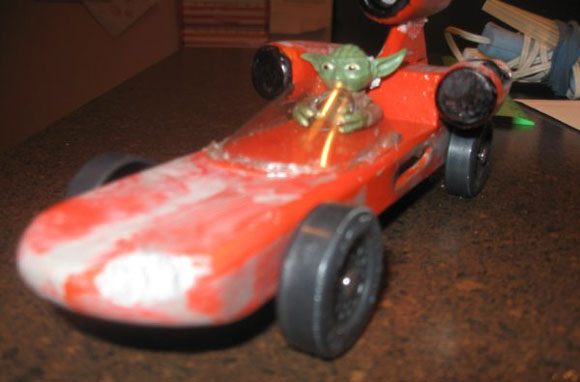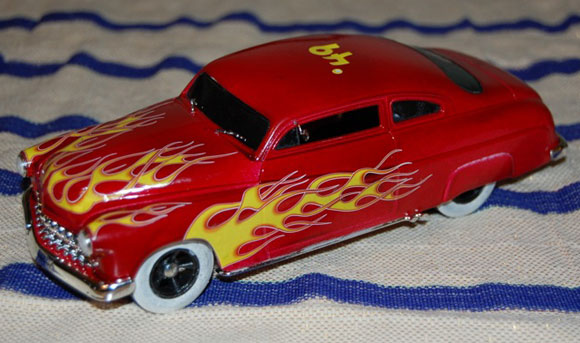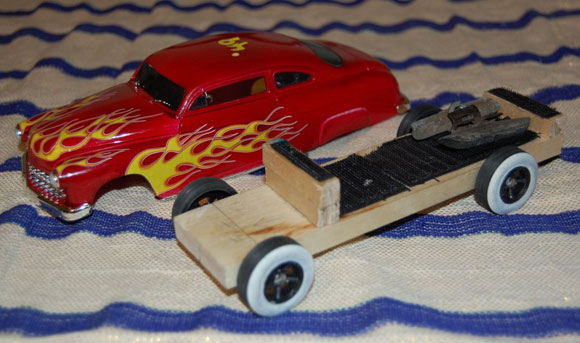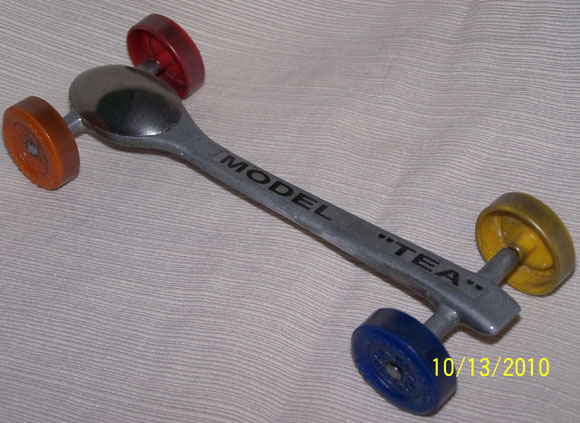– Feature Article – Rule Pet Peeves
– Pinewood Derby Car Showcase
– Q&A
Rule Pet Peeves
(An update of an article published in Volume 4, Issue 4 on November 17, 2004)
I receive lots of questions and comments from our readers about rules. Many times the person is asking me for the rules for their race, or for a clarification on a point. Sometimes, the person is griping about the rules, especially when the race leader appears to them to be misinterpreting the local rules.
In these cases, I can’t do much more than lend a sympathetic ear. Local rules are out of my control, and I certainly can’t jump in the middle of a rule dispute. But during these times I certainly do wish that the local race leaders would take the time to document a clear set of rules. So much miscommunication, grief, griping, and anger would be mitigated by giving a clear set of rules to the race participants well before the race event.1
But there is a more fundamental question that needs to be answered when establishing rules. Even if the rules for the local race are clearly documented, a valid question is “Why?” Why is a particular technique allowed/banned? What is the rationale for allowing (for example) an extended wheelbase? Why do we need to have 4 wheels on the ground? Of course the list goes on.
In today’s article I would like to explore several common areas of pinewood derby design that are oftentimes regulated, and offer some guidance as to whether these design techniques should or should not be restricted.
General Guidelines
The purpose for rules is to make sure that the following criteria are met:
- Will the car run properly on the track (proper width, height, etc.)?
- Will the car run without any damage to the race equipment (too heavy, improper materials)?
- Is regulation required to maintain a level of equity? Some arbitrary limits – such as the five ounces maximum weight – are imposed to limit the range of options, thus maintaining a level of competitiveness.
- Is a particular technique commonly available to the other entrants?
Furthermore, the rules need to be in line with the rules of parent organizations when participants at the local level will be moving on to district level races.
Let’s take a closer look at several rule areas.
Modified Wheelbase
There are many advantages to longer wheelbase cars (see Volume 2, Issue 6 – “Modifying the Wheelbase”). So, should extended wheelbase cars be allowed in all races? Let’s look at the criteria from above:
Criteria
- Yes – the car will run properly.
- Yes – no damage to track.
- Yes – must be regulated for equity. A long wheelbase car has a distinct advantage over shorter wheelbase cars.
- Yes – anyone can extend the wheelbase using a hand drill or drill press.2 But some expense is involved.
Conclusion
Disallowing extended wheelbase cars is a limit set to maintain competition. If the local club allows wheelbase modification, then this should be documented in the rules so that participants know that they are allowed to modify the wheelbase. Also, the means to extend the wheelbase should be made available to all participants at a workshop. By the way, some organizations run two classes of cars: “Stock” – standard wheelbase only, and “Open” – Extended wheelbase allowed.
Lube Type
Many different lubes have been successfully used on pinewood derby cars, including dry lubes (graphite and PTFE), liquid lubes (Krytox 100 and Silicon), and some unusual ones (Pledge furniture polish, Armor All, and Talcum powder).3
Criteria
- Yes – the car will run properly.
- Yes and No – if used properly none of these lubes will cause damage. but if used to excess, many of the lubes can stain the track (including graphite).
- No – not required for equity. Many different lubes can be used with reasonable success.
- Yes – anyone can select an alternate lube.
Conclusion
Limiting the lube to a particular type is an arbitrary decision. Certainly, to protect the track the rules must specify that excess lube be removed before the car is turned in. But limiting the lube to one type is not necessary. Different lubricants are widely available, and in fact, the choice of lube is an area where human ingenuity comes into play!
Four Wheels On The Ground
Having three wheels on the ground can be a speed advantage. But beyond this, it is much easier to build a car with three wheels on the ground than with four. Even when four wheels touch the ground, normally three of the wheels hold the weight of the car while the fourth wheel just barely touches.
Criteria
- Yes – the car will run properly.
- Yes – no damage.
- No – not required for equity. Although there can be an advantage to running a three-wheeled car, the advantage depends on proper alignment.
- Yes – in fact it is easier to run three than four on the ground.
Conclusion
Limiting the car to four wheels on the ground is arbitrary. Since it is easier to implement, I strongly recommend allowing three wheels on the ground.
Lathed Wheel Tread
Many car kits are equipped with wheels that are badly out of round. To improve the performance, the wheels can be trued.
Criteria
- Yes – the car will run properly.
- Yes – no damage.
- Yes – required for equity. Rounder wheels are faster.
- Yes – anyone can true wheels.4 But some expense is involved.
Conclusion
Limiting the car to non-trued wheels does serve to maintain competition. However, if your organization uses wheels that are severely out of round, consider allowing trued wheels, and offer the means to true wheels at a workshop.
Wheel Diameter Specification
Recently, many packs have instituted a minimum wheel diameter rule. I believe the intent of the rule is to try to catch trued wheels. However, this type of rule will not specifically catch lathed wheels, but instead makes it more difficult on parents that try to prepare wheels with a mandrel and sandpaper.
Criteria
- Yes – the car will run properly.
- Yes – no damage.
- No – not required for equity. Smaller diameter wheels run slower.5
- Yes, anyone can change the wheel diameter, but determining the size of the wheel requires a digital caliper.
Conclusion
Specifying a diameter restriction serves no purpose. If an entrant wants to use very small diameter wheels, they will be less, not more competitive.
Modified Wheel Geometry
The speed of the car can be improved by reducing wheel mass through tread reduction. This can be done in many ways including drilling holes in the wheels, hollowing out the wheel, creating an “H” or “V” tread wheel, and by narrowing the tread.
Criteria
- Yes – the car will run properly.
- Yes – no damage.
- Yes – required for equity. Some modifications can greatly improve speed.
- No – although they can be purchased, accurately modifying the geometry of a wheel requires either special machinery and/or extensive trial and error.
Conclusion
Since wheel modification is beyond the ability of many race participants, I recommend limiting wheel modification to “Open Competition” races.
Aftermarket Axles
Aftermarket axles are available which require less preparation. Some of the these axles can improve the speed of the car, but most just simplify the car building process.
Criteria
- Yes – the car will run properly.
- Yes – no damage.
- Yes and No – some aftermarket axles may improve speed, while others do not.
- Yes – aftermarket parts are available, but an expense is involved.
Conclusion
The purpose of providing a kit is so that each participant uses the same basic materials. However some kits provide axles that require extensive work.6 In these cases groups should consider offering aftermarket axles to all participants, or change to a different kit.
Upturned Nose Or High Nose Car
Several people have mentioned to me recently that their rules state that the front edge of the car must be at the bottom of the block. If the block is tapered upward from the bottom to the nose, then the car is disqualified. The rationale for this rule is that a car with a front edge positioned higher on the block will have an advantage.
Criteria
- Yes – the car will run properly.
- Yes – no damage.
- No – not required for equity for the vast majority of tracks. All modern tracks are equipped with spring-loaded gates which negate any advantage of a high nose car.7
- Yes – anyone can build a car with an upturned or high nose.
Conclusion
A restriction on the shape of the block is arbitrary and limits creativity. I recommend not regulating the position of the front edge of the car.
Conclusion
There are certainly other rules that should be reviewed to determine whether there is a basis for the restriction. I encourage all race leaders to thoroughly review the local rules and make modifications where needed.
1In Volume 2, Issue 2 – “It’s the Law! – A Sample Rule Set for Your Pinewood Derby”, I provided an outline for a complete set of rules. Just fill in the blanks for your organization.
2The Pro-Body Tool is a drilling guide to accurately drill axle holes with a hand drill.
3I do not personally vouch for any of these products except graphite and Krytox 100.
4The Pro-Wheel Shaver is a device for truing wheels. In addition, trued wheels are available from many sources.
5The smaller the wheel, the more times it must rotate to make it to the finish. Thus, a small wheel must rotate faster than a larger wheel. The fastest wheel is of the largest diameter, the most accurate, and the lightest weight possible. But to make a wheel accurate, you must reduce the diameter. So, there is a trade-off between wheel accuracy and wheel diameter.
6One of my pet peeves is the nail axles in the BSA kits. Removing the burrs is a difficult process for many people. Certainly BSA could include axles without burrs at little to no cost increase. But until such a time, people will continue to purchase aftermarket axles BSA Speed Axles.
7This was proven to be the case in Volume 10, Issue 2: Cheater Bars – Do they Work
Pinewood Derby Car Showcase
Land Speeder – Martin Zeppetello
My son wanted an X-Wing fighter, but we settled on a Land Speeder with Yoda as pilot. As you can see by the paint job, this Land Speeder has seen some Imperial action! I somehow miscalculated the lead in the jet pods and had to remove 1/2 ounce of wood after we had already removed a considerable amount. But we got to 5 ounces, and then took 2nd overall out of 54 cars (and our design was enjoyed by all).
’49 Mercury – Don Hales
This is my 1/24 scale 1949 Mercury Coupe (Lead Sled) “Door Slammr” that I entered in the Sunset Speedsters Cup Race. The basic premise of a “Door Slammr” is to marry a 1/24 or 1/25 scale plastic model car body (your discretion) to a pinewood frame and use BSA, PineCar, Awana, etc. standard wheels. The maximum car length is 8 inches unless the plastic body is longer (like a ’59 Cadillac Eldorado) and the maximum weight is bumped up to 6 ounces. There are many ways that you can choose to attach your car body to the frame; I chose to use three pieces of square wood rod for body supports. Then I used Velcro pieces on the top of the supports and on the inside of the body to firmly hold the body in place. The windows are painted black on the inside to give the windows that “Tinted Limousine” look. The car setup and weight placement are similar to standard pinewood derby cars.
The “Door Slammr” division has been a hit with the parents at our races. I encourage all you men and women who have the urge to race in a derby to build a “Door Slammr” of your all-time favorite car and start a “Door Slammr” division for Adults; or start your own racing league (like I did) and run four or five times throughout the rest of this year!
Model “Tea” – Brandon, Dawn, & Michael Jones
Our Model “Tea” was a play on words of the Model “T” car and a “Tea” Spoon. My son, Brandon came up with the idea when I showed him a tungsten canopy. We placed it in different positions and then he thought of it being the underside of the bowl of a spoon. Brandon’s mother, Dawn, came up with the name. The design of the car was to keep it narrow and thin, like a spoon, while having the bend where the bowl is. The weight is a 3-1/2 ounce tungsten canopy, plus a 1/2 ounce tungsten cylinder, and some tungsten putty and beads. It was very difficult to get the car to five ounces considering how thin it was. The Model “Tea” placed 1st in den and 2nd Overall for speed, and “Most Aerodynamic” for design.
Q&A
Do you make any pro body tools that accommodate widths wider than the minimum 1 3/4 inches? In our race, the width of the car can be up to three inches. I’d like to experiment with a slightly wider rear wheel base and see if it might allow only one front wheel to ride the guide rail.
Sorry, all of the body tools are intended for 1-3/4 inch blocks. Note that while the overall width of the car can be wider, the actual guide rail is still (typically) 1-5/8 inches wide. So you want to keep the wheels closer together (typically just under two inches between the inside edge of the wheels). If the wheels are spread further apart the car has more opportunity to shift left or right. This will reduce performance, and can cause your car to hit cars in the neighboring lanes.
I am seeking information about the fastest stock wheel. We can use any stock wheel for our races and I would like your input on which you feel is fastest.
All else being equal, lighter wheels will result in a faster car. But, of course, wheel accuracy does matter.
Stock Awana wheels generally outperform stock BSA wheels (Awana 2.2 grams, BSA – 2.7 grams). Just make sure to use the Awana axles, which fit the wheels nicely. Note that the Awana wheels are a bit flexible, so if you are going to run with a weight greater than 5 ounces, you might want to go with the BSA wheels (which are harder and stiffer).
Another option is the Super Stock Wheels (part 4094). I don’t know if they would be considered “stock” for your race, but if so, they would be faster than either Awana or BSA, as they weigh only 1.8 grams and are very accurate.
Want Answers?
Do you have a pinewood derby-related question? If so, e-mail us your question.We answer all questions by e-mail, but not every question will appear in the Q&A section of the newsletter.
Back Issues
Are you a new subscriber, or have you missed some of the previous newsletters? Don’t miss out; all of the issues for Volume 5 through Volume 17 are posted on our web site.
Newsletter Contributions
We welcome your contributions. If you would like to contribute an article, a web site review, a speed tip, or a pinewood derby memory, please e-mail us.
Subscription Information
The Pinewood Derby Times is a free e-newsletter focused on pinewood derby racing. It is published biweekly from October through March.
If you haven’t already done so, please forward this issue to your pinewood derby friends. But please don’t subscribe your friends. Let them decide for themselves. Thanks.
If this newsletter was forwarded to you, why not subscribe to receive this newsletter. There is no cost, and your e-mail address is safe, as we never sell or share our distribution list.
To subscribe, send a blank e-mail to
pi*********************@*******st.com
You will receive a confirmation e-mail. Reply to the confirmation e-mail and you will start receiving the Pinewood Derby Times with the next issue.
Randy Davis, Editor, Pinewood Derby Times
E-Mail: in**@**************ty.com
(C)2018, Maximum Velocity, Inc. All rights reserved. Please do not reprint or place this newsletter on your web site without explicit permission. However, if you like this newsletter we grant permission, and encourage you to e-mail it to a friend.
Maximum Velocity disclaims any personal loss or liability caused by utilization of any information presented in this newsletter.
The Pinewood Derby Times is not specific to, and is not affiliated with the Boy Scouts of America, YMCA, Awana, or any other organization.
(R)Maximum Velocity is a registered trademark of Maximum Velocity, Inc.
(R)Pinewood Derby is a registered trademarks of the Boys Scouts of America.
(R)Awana is a registered trademark of Awana Clubs International.
All other names are trademarks of their respective owners.




